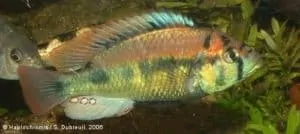Lamprologus ocellatus – Ocellated Shell-dweller
Lamprologus ocellatus belongs to the Shell-dwelling Cichlids of Lake Tanganyika. The females lay their eggs in snail shells and incubate them in the shells. They occur in almost the entire lake at depths of 10 to 40 meters in the sandy zones.
Description
Like all shell-dwelling cichlids, the Lamprologus ocellatus is not large. The males reach a length of about 6 centimeters and the females remain a bit smaller at 4 centimeters. In an aquarium you can keep 1 male with 1 female. If the aquarium is wider than 80 centimeters, you can keep several females, but make sure that the snail shells are spread throughout the tank, so that they can build their territory as far away from the other as possible. The females can also be very aggressive among themselves.
Breeding
A female chooses the most suitable one from the available shells. The shell is dragged to the place where the female wants to establish her territory. She digs the shell into the sand until only the opening is visible.
Once the female is ready to mate, she lures the male to her shell with vibrating movements. The female deposits a neat row of about 15 to 20 eggs deep in the shell. The slightly larger male cannot get very deep into the shell, so he releases his sperm at the entrance to the shell. The female waves the sperm towards the eggs with her pectoral fins to fertilize them.
The eggs hatch after about 3 days, during which time the female waves her pectoral fins with fresh, oxygen-rich water into the shell. In the meantime, the male defends the shell against predators. Despite its small size, the ocellatus defend their territory very fiercely, even against much larger species. After hatching, the young live on their yolk sac for a few days. After this they can be fed with fresh artemia and later also cyclops and Daphnia.
The Aquarium
The adults do not make too many demands on the aquarium. A few snail shells per fish and enough sand are enough. They are also not very picky with food. Live or frozen food such as krill, mysis, white mosquito or cyclops alternated with cichlid pellets and flakes are sufficient. Make sure there is enough variety. If there is insufficient live or frozen food, they will grow more slowly and even lose weight later.
Lamprologus ocellatus is not kept for its beautiful colors. They have a beige/brown ground color with the back being slightly darker brown. De onderste helft van het lichaam heeft een metalig blauw/violette glans. The gill covers have a dark eye spot (ocellatus) that often has a greenish glow.
What the Lamprologus ocellatus lacks in color it more than makes up for in its fascinating behavior. They are very active and are always busy arranging the sand around their shell better or trying to get their shell in a better place.
Video
Author
John de Lange
Copyright images
Mattijs Meindertsma
Suephoto.com (original website no longer availabel)















Reviews
There are no reviews yet.